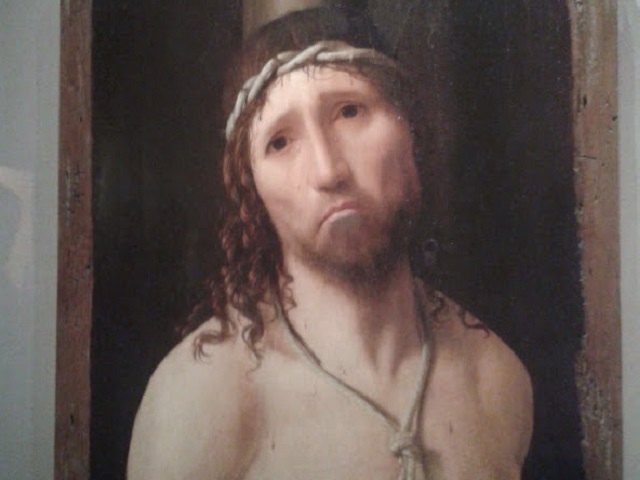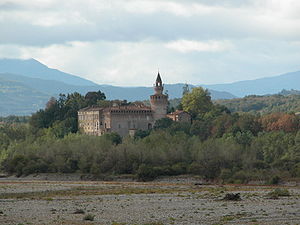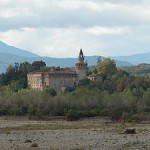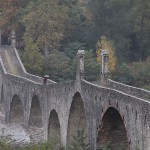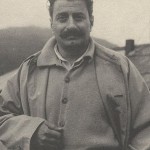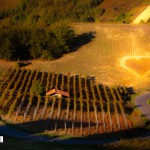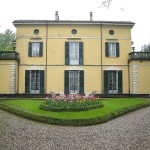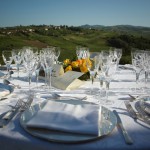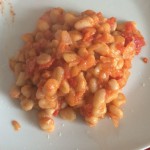From Val Tidone to Piacenza: 800 years of history in one day
Eight centuries in a single day is possible, along one of the trails of the soul that lead from Val Tidone to Piacenza.
Our journey begins in Vicobarone, a small village in the municipality of Ziano Piacentino, where Podere Casale is located.
After our abundant breakfast prepared for us by Signora Daniela, before getting into our car, we visit the parish church of Vicobarone. The present construction dates to 1854, but a previous church, of which there are no visible traces today, was built on the same cite and documents date to the year 1143.
After admiring the altarpiece by Francesco Scaramuzza and statues by Ettore Cedraschi, we head towards the village of Rivalta along the Trebbia river.
In only twenty minutes by car we are visiting the tower attributed to Pietro Antonio Solari, the same architect who from 1487 worked in Moscow at the construction of the Cremlin towers.
The Castle of Rivalta dates to a period previous to the modifications carried out in the second half of the 15th century and later ages. The neo-classic façade dates to the year 1780 as well as the grand staircase which leads to second floor. However, the first documentation of the Castle dates to the year 1025 in a purchase deed.
The Castle and surrounding village of Rivalta belong to the Landi family since the first decades of the year 1300 and they are still the owners after more than seven hundred years.
The Castle, in part inhabited by Conte Zanardi Landi and his family, is open to the public for guided tours through the rooms rich in history and fascination with furnishings collected by the Landi family over the centuries.
During our visit we can admire:
- the ball room twenty five meters in length with a grand sandstone fireplace in the center.
- The dining room and kitchen where the ghost of the cook Giuseppe lingers, assassinated by the butler in the 700’s because he had seduced his wife.
- The cellar and prisons
- The green room, where important guests sojourn, furnished with pieces and paintings of the XVI and XVII centuries
- The red room, known as the Falcon, with a red damask four poster bed and Brescianino painting portraying the landing of Onorio Scotti in Cyprus.
- The museum which includes the room of arms, dedicated to the battle of Lepanto, the room dedicated to explorations and sacred art, and the museum of military uniforms.
- The long hall way with access to various parlors
- The billiard room
- The circular tower with its bladed pit.
Our visit of the Castle has finished and it is time for lunch. We are going to a characteristic and hospitable agriturismo only a few kilometers from Rivalta.
Agriturismo Corte del Gallo is located on the hills above Rivergaro, in the village Case Basse, half way up Val Trebbia, not far from the river.
The estate covers 20 hectares where agriculture, cattle and horse breeding have been carried out for more than twenty years. Riding stables offer horseback riding lessons, and excursions through the wild, fascinating surrounding territory which Ernest Hemingway defined the most beautiful in the world.
This country farm offers hospitality in 8 rooms and its restaurant serves typical, traditional Piacenza cuisine.
Heart and soul of Corte del Gallo, which is family run, are Anna Porcari, her mother Mariuccia and her brother Elia Sartori who manages the restaurant and selects the wines.
Anna is the chef and queen of the kitchen which she manages with expert care thanks to the tradition and secrets inherited from her grandmother Luisa. Anna guarantees the continuation and memory of the past through her passion and enthusiasm projected to the present and future.
The specialties Anna prepares are tortelli with squash, tortelli with gorgonzola and nettle, tortelli with sage and butter. The pasta has to be “rolled thin” Anna tells us with all the pride of one who does the job well.
All the quality raw materials come from the farm or from local producers, and the wide spaces in the country make Corte del Gallo the ideal place for families with children. The clientele is mainly from Piacenza and Milan. The loft above the dining room is decorated with a collection of vintage motorcycles and antique farm equipment.
It is impossible to get bored at Corte del Gallo. Anna and Elia organize evenings for dancing and karaoke, talent shows, culinary contests like the contest between Sardinian and Piacenza cuisine and the Festa of Saint Antonio with vin brulè, benediction of the animals and a horse show.
Having finished our abundant lunch, content and full, we get back in the car and head for Piacenza.
To visit all of the palaces, the churches and the museums of this ancient town, founded by the Romans in the year 218 B.C., obviously an afternoon is not sufficient , probably not even a week.
For the time being, we will limit our visit to a walk through the historic center to admire Palazzo Gotico, Piazza Cavalli, with the two bronze statues dating to the 600’s and the work of Francesco Mochi from Montevarchi, that give the name to the piazza, the church dedicated to Saint Frances of Assisi facing the piazza, and after walking down via XX Settembre, Piazza del Duomo with the elegant and austere cathedral. For more information, we suggest you read the article we have dedicated to the four churches to visit in Piacenza.
Our final destination on this brief trip through eight centuries is right outside the city: Collegio Alberoni
The construction of this ancient seminary was ordered by Cardinale Giulio Alberoni and inaugurated in 1751. Still today, after three centuries, the Collegio continues to operate and supports itself with the income derived from the surrounding land a part of the property from its foundation.
Aside from a school for the formation of young, poor seminarians, just as Cardinale Alberoni was before making his fortune, the Collegio has a very rich art gallery, open to the public, with works of art such as Ecce Homo by Antonello da Messina as well as fabulous 16th century tapestries.
The vast structure also hosts an astronomic observatory, a rich library and a museum of natural history.
The guided visit to the Collegio, museum and art gallery lasts about an hour and a half.
Collegio Alberoni is approximately thirty six kilometers from Podere Casale and is a forty minute drive by car.
